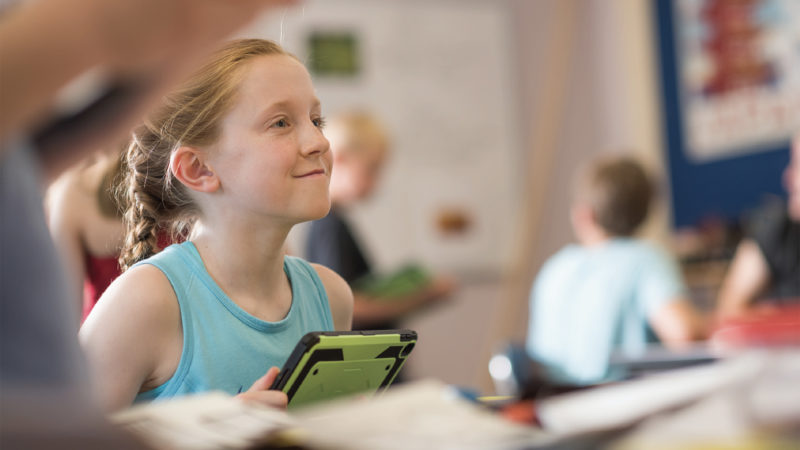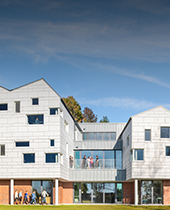5 Essential Elements of Technology Instruction for Young Learners
By Tim Hebda (4-5 faculty)
Technology has provided educators with tools that redefine the ways in which students learn and interact with their world. Fourth- and fifth-graders, for example, explore maps, historical documents, and first-hand accounts of workers from the Industrial Revolution. They can also digitally create their own manufacturing towns and share them with classes around the world.
Like many parents, you may be worried that schools are getting students hooked on technology. We all worry about screen time, what kids are watching outside of class, and whether they’re losing the capacity to experience the real world around them. Teachers need to prepare children for the future, and technology is going to be a big part of it. You just want to know that your school strikes the right balance. Here are five essential elements of a technology program that works for young learners.
1. Why teach technology?
While there are many desktop and mobile applications that can help students learn, not all of them inspire higher-order thinking or creative problem solving. At Waynflete, we don’t believe that “technology for technology’s sake” should be the driving force in classrooms. In fact, we don’t have dedicated technology classes in our Lower School (preschool through Grade 5). Instead, students learn new technology skills only when they are needed to extend learning. Technology can be used to personalize a student’s educational experience, to deepen and extend their understanding, and to empower them to share what they have learned. Students can do more than simply write the story of a recent immigrant or refugee, for example. In Waynflete’s Lower School, students use digital tools to post details of their interviews on the class blog for others to read and respond to. In science, students capture images of neighborhood plants they are studying and share them with real scientists who are investigating the spread of invasive species in Maine.
2. How can technology help students become the creators—not just the consumers—of knowledge?
You don’t want your child to rely on others to get them engaged in learning. You want them to be increasingly self-directed, to ask provocative questions, and to investigate things on their own. In Waynflete’s Lower School, we use technology to help kids identify reliable online sources and share and debate their findings on podcasts and blogs. By using this technology, the students—not the teachers—are creating content.
3. Can technology be used to make sure that no one is left out?
Every student has different interests and a unique learning profile. Technology and class structure allows educators to better provide for their students by personalizing learning and differentiating instruction. As a result, students are empowered and motivated to learn. They have an opportunity to make choices and to share their voice within the classroom, the school, the community—and even the world.
Once a class has learned the essential elements of a concept, technology enables teachers to create mini-lessons that are directed at the individual needs of students (these needs are identified after reviewing student work). While educators work with small groups of students, individual learners can access these personalized mini-lessons, receiving video-based feedback and direct instruction that have been prepared in advance by their teachers. Students can pause and rewind as needed, providing the learner with control over their own learning. Once small-group instruction has ended, the teacher can meet with each student individually to follow up on the content of the video and the progress of the student. This “flipped approach” works well with writing workshops.
4. Technology cannot replace time-honored essential skills.
You know that there are critical skills that can’t be taught through technology. Some skills require small classes that give teachers the opportunity to work with children in groups and or in a one-on-one setting to help students master reading, writing, math, and speaking skills. Written language is a critical tool for teaching children how to think. That’s why Waynflete students write across the curriculum. It’s common to see Lower School students mapping out an argument on the wall or the floor using old-school sticky notes and index cards. Skills like critical thinking and learning how to listen to other points of view require face-to-face discussion and conversations.
At Waynflete, we believe that positive relationships are the foundation of a successful school environment. Students need individualized instruction targeted to their specific needs and a sense of belonging in order to learn. Small class sizes that emphasize personal decision making, rigor, and playful exploration are central to our daily work.
5. How can we make digital technology safe for kids?
We all know that mobile devices can provide amazing learning opportunities and connections. But we also know that they have destructive potential, particularly for kids. That’s why technology must be part of a school’s social curriculum. Technology in the classroom provides teachable moments about everything from how to politely respond to an email to understanding how quickly a hurtful comment about a friend can go viral—even when you didn’t mean it.
We ask these essential questions at Waynflete: How do we want to be treated? How should we treat others? These questions are embedded in our teaching of technology. We also take the time to inform students about safe passwords, digital footprints, and what to avoid on the internet.
Carefully integrated technology has been proven to increase students’ academic performance. By providing a flexible approach to learning—and instilling a sense of balance on the use of technology—young learners will be prepared to skillfully harness the abundance of resources available to them.



